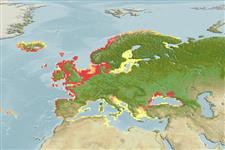Common names from other countries
Environment: milieu / climate zone / depth range / distribution range
Ekologi
; payau; kisaran kedalaman 0 - 50 m (Ref. 434). Subtropical, preferred 11°C (Ref. 107945); 74°N - 23°N, 16°W - 44°W
Northeast Atlantic and the Mediterranean.
Length at first maturity / Size / Weight / umur
Maturity: Lm ? range ? - ? cm Max length : 8.9 cm TL jantan/; (Ref. 434)
Found in both marine and oligohaline waters (Ref. 95752). Also inhabits brackish lagoons (Ref. 2779). Found on fine sand or slightly muddy sand (Ref. 434); also over coarse sand (Ref. 96391). Juveniles are epifaunal on seagrass and bare sand flats (Ref. 106879). Mobile (Refs. 95752, 96470). Free-living (Ref. 3123). Able to occupy areas with high exposure and low salinity (Ref. 95730). Carnivorous (Refs. 95752, 96470). Feeds on small benthic organisms (small crustaceans, annelids and mollusks) and fishery discards (Ref. 434).
Life cycle and mating behavior
Kematangan | Reproduksi, perkembang biakan | Pemijahan | telur-telur | Fecundity | Larva
Members of the order Decapoda are mostly gonochoric. Mating behavior: Precopulatory courtship ritual is common (through olfactory and tactile cues); usually indirect sperm transfer.
rujukan utama
Acuan | Koordinator | mitra
Fischer, W., G. Bianchi and W.B. Scott (eds.). 1981. (Ref. 434)
Status IUCN Red List (Ref. 130435)
status CITES (Ref. 108899)
Not Evaluated
Not Evaluated
penggunaan manusia
Perikanan: komersial
FAO - Perikanan: landings, profail spesis | FishSource | Sea Around Us
Alat, peralatan
Sumber internet
Estimates based on models
Preferred temperature
(Ref.
115969): 8.6 - 14, mean 10.5 (based on 410 cells).
Daya lenting
Rendah, Waktu penggandaan populasi minimum 4.5 - 14 tahun (K=0.09-0.11).
keancaman
Low vulnerability (10 of 100).
